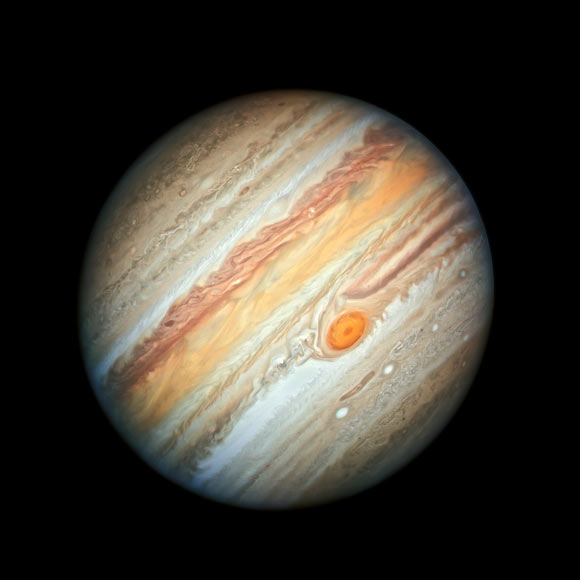Hubble Snaps Super-Sharp Image of Jupiter | Astronomy – Sci-News.com
The NASA/ESA Hubble Space Telescope obtained a detailed image of Jupiter on June 27, 2019, when the gas giant was approximately 400 million miles (644 million km) from Earth. The image features Jupiter’s most distinctive feature, the Great Red Spot, and a more intense color palette in the clouds swirling in the giant planet’s turbulent atmosphere than seen in previous years.

This new Hubble image of Jupiter, taken on June 27, 2019, reveals the giant planet’s Great Red Spot, and a more intense color palette in the clouds swirling in Jupiter’s turbulent atmosphere than seen in previous years. The colors, and their changes, provide important clues to ongoing processes in Jupiter’s atmosphere. The bands are created by differences in the thickness and height of the ammonia ice clouds. The colorful bands, which flow in opposite directions at various latitudes, result from different atmospheric pressures. Lighter bands rise higher and have thicker clouds than the darker bands. Image credit: NASA / ESA / A. Simon, NASA’s Goddard Space Flight Center / M.H. Wong, University of California, Berkeley.
The Great Red Spot is a spinning, cyclone-like storm just south of Jupiter’s equator.
It is shaped like a wedding cake, whose upper haze layer extends more than 3 miles (5 km) higher than clouds in other areas. Its reddish color is likely a product of chemicals being broken apart by solar UV light in the planet’s upper atmosphere.
Measuring in at 10,000 miles (16,000 km) in width, the Great Red Spot is 1.3 times as wide as Earth.
It has been monitored since 1830 and has possibly existed for more than three centuries. In modern times, the storm has appeared to be shrinking. The reason for this change is still unknown.
“Among the most striking features in the image are the rich colors of the clouds moving toward the Great Red Spot, which is rolling counterclockwise between two bands of clouds,” Hubble astronomers commented.
“These two cloud bands, above and below the Great Red Spot, are moving in opposite directions.”
“The red band above and to the right (northeast) of the Great Red Spot contains clouds moving westward and around the north of the giant tempest.”
“The white clouds to the left (southwest) of the storm are moving eastward to the south of the spot.”
All of Jupiter’s colorful cloud bands in the Hubble image are confined to the north and south by jet streams that remain constant, even when the bands change color.
The bands are all separated by winds that can reach speeds of up to 400 mph (644 kmh).
“On the opposite side of the planet, the band of deep red color northeast of the Great Red Spot and the bright white band to the southeast of it become much fainter,” the researchers said.
“The swirling filaments seen around the outer edge of the red super storm are high-altitude clouds that are being pulled in and around it.”
“A worm-shaped feature located below the Great Red Spot is a cyclone, a vortex spinning in the opposite direction to that in which the giant storm spins.”
“Another interesting detail is the color of the wide band at the equator. The bright orange color may be a sign that deeper clouds are starting to clear out, emphasizing red particles in the overlying haze.”
These observations of Jupiter form part of the Outer Planet Atmospheres Legacy (OPAL) program, which began in 2014.
This initiative allows Hubble to dedicate time each year to observing the outer planets and provides scientists with access to a collection of maps, which helps them to understand not only the atmospheres of the giant planets in the Solar System, but also the atmosphere of our own planet and of the planets in other planetary systems.






